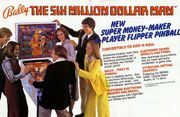
The machine's back glass
The Six Million Dollar Man pinball machine was released in October 1978 by Bally. Its game play was designed by Greg Kmiec with art by Dave Christensen, and had a production run of 10,320 units.
Design features[]
Six-player action[]
Unusually for its time, it could support up to 6 players. The ostensible benefit of this, in an age when most pinball machines only allowed for 4 players, was that arcades would be able to attract more people, and thus more money, to the game. However, this was likely counterbalanced by the fact that any one game would have taken longer than on rival machines, discouraging new players from trying the game. It is unknown whether the feature actually resulted in the game actually being more profitable.
Playfield innovations[]

A part of the promotional flyer for the machine
The Six Million Dollar Man was an early adopter of the "Play-More" post. This device, when earned by obtaining a sufficient score, popped up between the flippers to prevent the ball from dropping.[1] Furthermore, it marked the return of the Bally "free ball gate" — a device which, when a player fully illuminated the "BIONIC Power Score", would put an additional ball in play. Though certainly not unique to this game, the feature was proudly announced in Bally promotional material as something that "will be welcomed by pinball afficianados everywhere". [2]
Electronic circuitry[]
The game was arguably innovative for its use of "100% electronic circuitry". This allowed for easy conversion between two different types of game, "standard" and "add-a-ball". In a standard game, it was possible to win an extra game, whereas with "add-a-ball", the incentive wasn't a free game, but extra balls, which could— theoretically — prolong the length of a game indefinitely.
These electronics also allowed for the inclusion of six different musical tunes as well as "space-age sound effects" — making it an unusually "noisy" game for 1978. [2] They also allowed each individual sound to be turned on or off. [3]
High scores could be "remembered" by the game's software, thereby giving players additional incentive to play.
The game's onboard programming gave sophisticated accounting details. Operators could conveniently display a comparatively wide-ranging number of details, such as total number of coins dropped, total number of times a new high score had been posted, and the total number of games played versus total number of paid games played.
Generally, though, the electronic nature of the game's design afforded unusual flexibility for a game of this era. Almost every part of the game, from the points awarded for a ball hitting a bumper. to the rewards offered for beating the high score — even the number of credits extended by a putting a coin into a particular coin drop — could be modified. [3]
References[]
- ↑ RePlay Pinball of Luzern, Switzerland
- ↑ 2.0 2.1 The Six Million Dollar Man promotional flyer
- ↑ 3.0 3.1 Bally game manual
